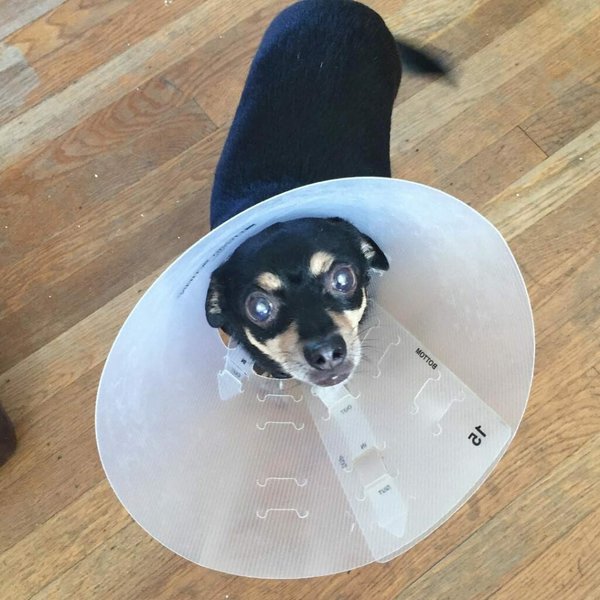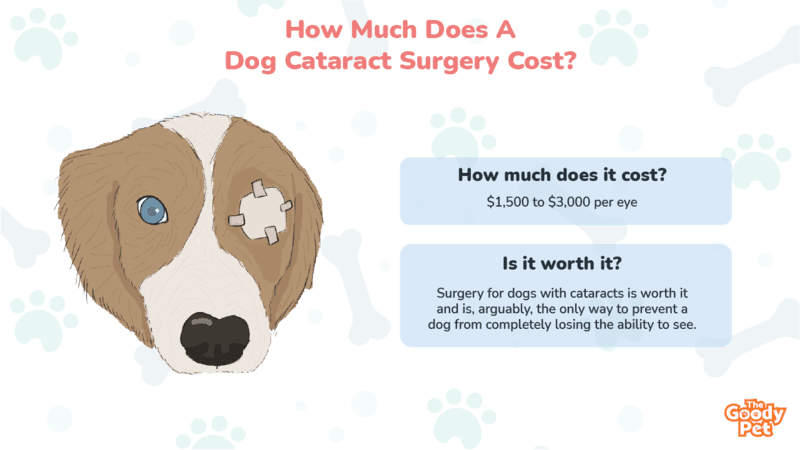Cataracts are one of the most common canine eye conditions that are responsible for loss of sight. But in most cases, it is possible to restore normal sight in the affected dog via surgery.
So, how much does a dog cataract surgery cost? Cataract removal surgery for dogs is an expensive procedure and it typically costs between $1,500 to $3,000 per eye. This sum of money typically covers operating and equipment costs, the use of anesthesia during the surgical procedure, as well as the surgeon’s skill and time.
Prompt and timely medical attention is required to ensure that canine cataracts don’t degenerate into permanent blindness. And most times, a surgical procedure known as phacoemulsification is the surest way of effectively combating dog cataracts.
This article aims to explore the pros of allowing your dog to go under the knife to get rid of its cataracts. But before we go into that, let’s see how much it’ll cost you to pay for surgery to remove cataracts from your dog’s eyes.
How Much Does It Cost To Remove A Cataract From A Dog’s Eye?
The average cost for surgery to remove a cataract from a dog’s eye typically ranges between $1,500 to $3,000 per eye. And this amount usually covers the cost of anesthesia, operating room use, hospitalization, and post-surgery treatment.
The amount required to carry out a canine cataract surgery is on the high side because this is an extremely delicate procedure that requires a great deal of skill and specialized equipment to carry out.
Cataract surgery is typically covered by reputable pet insurance companies, but this is only if the dog hasn’t been diagnosed with cataracts prior to getting the pet health insurance.
How Is Canine Cataract Surgery Carried Out?
The surgical procedure used to get rid of canine cataracts is medically referred to as phacoemulsification, and it is carried out following the steps listed below:
Medical And Physical Examination
The first, and significantly important step that needs to be carried out before embarking on the surgical procedure to remove cataracts from a dog’s eyes, is a thorough and concise medical examination of the pooch in question.
These tests are necessary to check for the presence of eye conditions such as lens rupture or retinal detachment that may potentially cause complications during the surgical procedure to remove cataracts.
If these medical tests show evidence of a retinal disease, high intraocular pressure (commonly known as glaucoma) or abnormalities with the dog’s blood, then such a pooch may not be suitable for surgery.
Surgical Procedure
If the dog is certified medically fit to go under the knife, the vet surgeon can then proceed to embark on the procedure to remove cataracts from the pooch’s eyes.
The surgical procedure to remove cataracts from a dog’s eyes involves the use of an ultrasonic device to break up cataracts and remove the pooch’s cloudy lens. This procedure is usually carried out under anesthesia, and it is typically completed between 45 minutes to 90 minutes.
Once this cataract-infested lens is removed, the surgeon then proceeds to fix an artificial intraocular lens in the dog’s eyes. The replacement of the dog’s natural lens with this intraocular lens is necessary to restore normal vision after completion of the surgery.
What Happens After Surgery?
Once the cataract removal surgery is completed, the dog is left behind at the hospital for at least one day so that the vet surgeon can monitor for the development of post-surgery complications.
The period after the successful completion of a canine cataract surgery is quite critical as it typically has an impact on the dog’s long-term prognosis. In most cases, dogs that have undergone cataract surgery will regain their sight almost immediately, but it is also possible that this process will take some days.
It is recommended that dogs that have undergone cataract removal surgery wear a protective collar for at least two weeks after the procedure to shield their eyes from accidental trauma.
The vet will also recommend the use of eye drops and oral medication, with the frequency of usage typically decreasing till the dog’s eyes are completely healed.
What Is The Success Rate Of Cataract Surgery For Dogs?
The success rate for the surgical removal of cataracts in dogs is considerably high.
And 9 out of 10 (90%) dogs that undergo this procedure will come out with their sights well and truly restored.
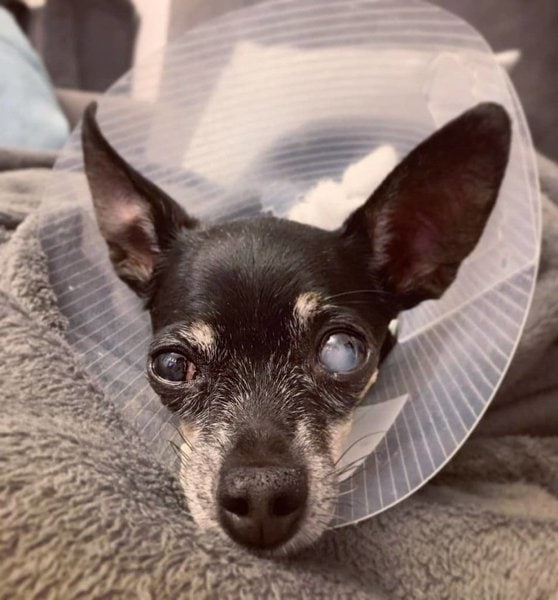
How Can I Get Rid Of My Dog’s Cataracts Without Surgery?
You can treat your dog’s cataracts at home by using vitamin supplements, antioxidants such as the coenzyme Q10 and oxycarotenoid supplements.
As stated earlier, canine cataract surgery has a high rate of success. But if you’re reluctant to let your furry friend go under the knife, you can employ some home remedies to manage cataracts in your dog.
However, before administering any of these treatments, you should know that these home treatment methods are mainly meant to delay the progression of cataracts. And your dog will eventually have to undergo surgery to prevent permanent loss of sight.
That said, some of the substances with which you can treat your dog’s cataracts at home include:
Vitamin Supplements
There have been strong claims by several dog owners that vitamin supplements can be effective in the battle against canine cataracts.
These vitamin A, vitamin C, and vitamin E supplements typically boast properties that make them effective at protecting the integrity of the dog’s eyes, as well as remedy the damage of certain tissue in the eyes.
Also, apart from their potential usefulness against cataracts, vitamin supplements have a host of other health benefits for your pooch; Hence, it won’t hurt to give them a try.
Antioxidants
Certain antioxidants such as the coenzyme Q10 are effective at glutathione regeneration, and this is especially beneficial for pooches that are still at the early stage of cataract formation.
This continuous regeneration of glutathione with the coenzyme Q10 helps slow down the progression of cataracts in dogs, while simultaneously strengthening the eyes and priming the dog for future surgery.
Coenzyme Q10 supplements are occasionally present in dog food, but if your pooch’s diet lacks this antioxidant, you can opt to purchase over-the-counter in capsule or liquid form and administer orally to the dog.
OxyCarotenoid Supplements
Oxygenated carotenoids such as Lutein and Zeaxanthin are effective at combating the oxidative breakdown of eye lipids that is associated with cataracts. And supplementing your dog’s meals with these oxycarotenoids typically helps strengthen and protect the pooch’s eyes from oxidative damage.
NOTE! The recommendations made above are not meant to replace proper medical care or to be administered without proper consultation. And you should discuss with your vet on the appropriate course of action, if your dog is diagnosed with cataracts.
Do Cataract Eye Drops For Dogs Work?
There has been an influx of eye drop products claiming to get rid of canine cataracts in recent years; however, there is scant evidence to suggest that these products actually work to remove cataracts from a dog’s eye(s).
That isn’t to say eye drops are without use in the fight against cataracts in dogs. And upon completion of a canine cataract surgery, the surgeon will typically prescribe the use of drops to prevent inflammation of the eyes.
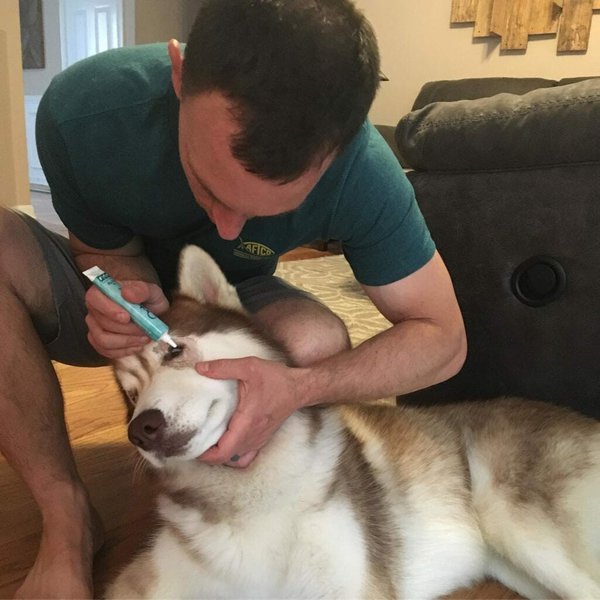
Is Cataract Surgery For Dogs Worth It?
Surgery for dogs with cataracts is worth it and is, arguably, the only way to prevent a dog from completely losing the ability to see.
How To Tell If A Dog Has Cataracts?
Some of the more noticeable signs that a dog may be suffering from cataracts include:
- Changes in eye color.
- Changes in the shape and size of the dog’s pupils.
- Swelling and bulging of the eyes.
- Cloudiness in the eye.
- Reddening of the eye whites.
- Behavioral changes such as staring, growling, or hesitation to climb or jump over elevated surfaces.
- Frequent scratching of the eyes.
- Bumping into objects and people much more frequently.
These symptoms are also associated with other medical conditions in dogs; Hence, to be sure that a dog manifesting these signs has cataracts, the appropriate course of action is to take such a pooch for a thorough medical examination immediately aforementioned signs are noticed.
What To Do If A Dog Has Cataracts?
Pending when a dog undergoes treatment to clear its cataracts, there are steps the dog owners can take to help their pooch prepare for the cataract removal surgery. And some of these steps include:
- Teach the dog to get comfortable with wearing a protective cone. This cone is typically placed on the dog after surgery to facilitate the recovery process.
- Carrying out the required medical tests to be sure that the pooch is physically fit to undergo surgery.
- For cataracts that develop due to diabetes, consult with your vet to develop a suitable feeding plan for the dog.
- The use of eye drops to reduce inflammation prior to the cataract surgery.
Can A Dog Live With Cataracts?
If, for one reason or the other, a pooch can’t undergo surgery to clear its cataracts, the owner should make preparations to help the dog cope with the gradual loss of sight.
These preparations include making minor changes and clearing the clutter around the home, ensuring the dog is never left unattended to in unfamiliar surroundings, and providing extra guidance during walks.
Fortunately, canine cataracts are non-fatal, and with help from their family, dogs can adapt well to the loss of vision that is the end result of leaving this condition untreated.
Canine cataracts can be painful at times. And in advanced cases, a matured, brittle cataract can break and float free within the dog’s eyes, and this can be dangerous for the pooch. To help your pooch cope with this pain, you should consult with your vet on the administration of pain meds.
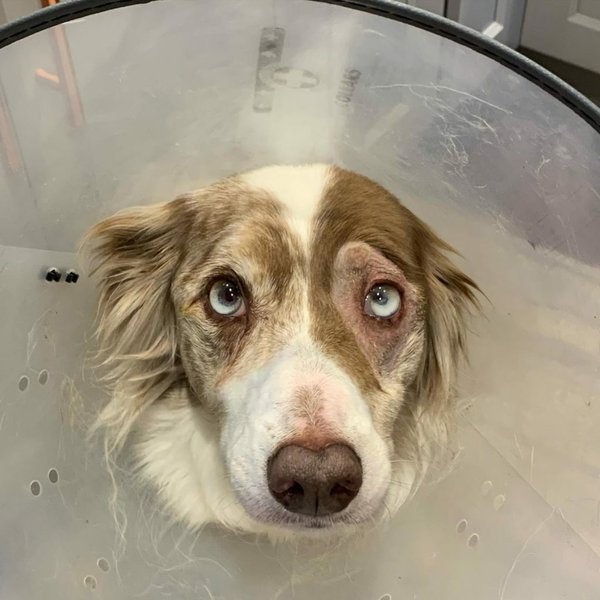
How To Take Better Care Of Your Dog’s Eyes To Prevent Cataracts?
Most cases of cataracts are genetically inherited or occur due to old age, hence there isn’t much you can do to prevent your pooch from getting this disease.
Monitor Your Dog’s Weight
It has been scientifically proven that canine cataract can develop as a side effect of diabetes; Hence, to reduce your pooch’s chances of contracting this disease, you should strive to keep the dog’s weight at an acceptable level.
Feed your pooch nutritious, high-quality dog food, and you can also consult with your vet on the use of dietary supplements, as needed.
Regular Physical Examination
By taking your dog in for medical tests at the appointed periods, your vet can catch on to the formation of cataracts at an early stage; This will, in turn, enable the vet make the necessary arrangements to ensure that the situation doesn’t degenerate into something serious for the dog.
